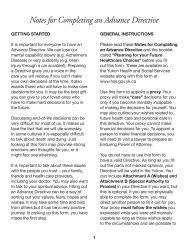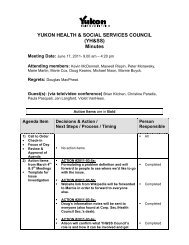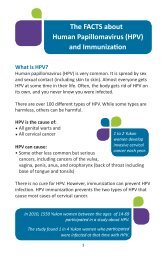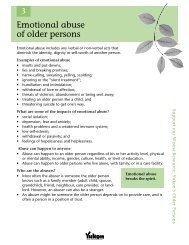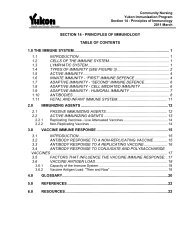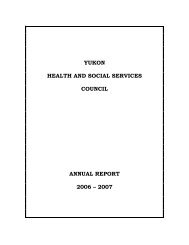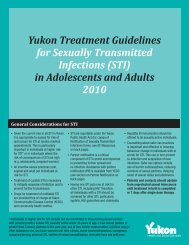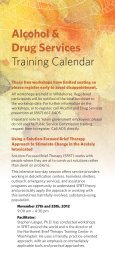Sports Nutreition for the Yukon Athelete
Sports Nutreition for the Yukon Athelete
Sports Nutreition for the Yukon Athelete
Create successful ePaper yourself
Turn your PDF publications into a flip-book with our unique Google optimized e-Paper software.
<strong>Sports</strong> Nutrition <strong>for</strong><br />
<strong>the</strong> <strong>Yukon</strong> Athlete<br />
“Stay Active. Eat Like a Champion.” 1<br />
A RESOURCE FOR YOUNG ATHLETES,<br />
COACHES AND PARENTS<br />
CREATED BY JANNA DYKSTRA<br />
YUKON FIRST NATIONS DIETETIC INTERNSHIP PROGRAM<br />
JANUARY 2009
Table of Contents<br />
Background In<strong>for</strong>mation ...................................................... 1<br />
Nutrition ............................................................................... 2<br />
Carbohydrate .................................................................... 3<br />
Protein .............................................................................. 4<br />
Vitamins and Minerals ...................................................... 5<br />
Fat .................................................................................... 6<br />
Hydration ............................................................................. 7<br />
Cold Wea<strong>the</strong>r .................................................................... 8<br />
<strong>Sports</strong> Drinks .................................................................... 9<br />
Energy Drinks ................................................................. 10<br />
Breakfast Tips ................................................................... 10<br />
Lunch Tips ......................................................................... 11<br />
Carbohydrate-Loading ...................................................... 12<br />
Appendices<br />
A. Nutrient Breakdown Examples .................................. 13<br />
B. Food Guide Daily Serving Checklist ......................... 14<br />
C. Sample Meal Plan - Athlete 1 ................................... 15<br />
Sample Meal Plan - Athlete 2 .................................... 16<br />
Sample Meal Plan - Athlete 3 .................................... 17<br />
D. Recipes ..................................................................... 18<br />
References ........................................................................ 19
Background<br />
Healthy eating and good nutrition play key roles in health<br />
and well-being. This is very true <strong>for</strong> young athletes. This<br />
group needs proper nutrients <strong>for</strong> growth as well as enough<br />
energy <strong>for</strong> sports. Eating well and drinking enough fluids are<br />
just as important <strong>for</strong> top per<strong>for</strong>mance as a team practice or<br />
training plan. This booklet will address how important eating<br />
healthy is how to eat enough <strong>for</strong> a busy lifestyle. These busy<br />
people are involved in school, sports and many o<strong>the</strong>r<br />
activities.<br />
This booklet was developed <strong>for</strong> male & female athletes<br />
(ages 9-18) who are already doing 30-90 minutes of physical<br />
activity at least three times per week. They are ready to<br />
make in<strong>for</strong>med choices to support good nutrition <strong>for</strong> <strong>the</strong>ir<br />
active lifestyle. This book is also a tool <strong>for</strong> <strong>the</strong> coaches and<br />
parents of <strong>the</strong>se athletes. It can be used as a tool to provide<br />
up-to-date in<strong>for</strong>mation about <strong>the</strong> nutrition needs of this age<br />
group. Each individual athlete is unique, so <strong>the</strong> nutrition and<br />
hydration needs <strong>for</strong> each person may differ. Knowing what<br />
each athlete’s nutrition needs are and learning what works<br />
<strong>for</strong> <strong>the</strong>m will help <strong>the</strong>m reach optimal nutrition.<br />
This booklet will highlight <strong>the</strong> main nutrition concerns <strong>for</strong> this<br />
age group. It will also provide healthy and tasty meal and<br />
snack ideas. These nutrition tips will enhance training,<br />
per<strong>for</strong>mance and health.<br />
1
Nutrition<br />
Proper nutrition during <strong>the</strong> teenage years is very important. Youth need to<br />
have enough calories in <strong>the</strong> diet to allow <strong>for</strong> proper growth and development.<br />
For youth athletes, <strong>the</strong>se needs are even higher, as <strong>the</strong>y are also burning<br />
extra calories during physical activity 1 .<br />
Nutrients that give you energy are carbohydrate, protein and fat. Energy is<br />
required <strong>for</strong> peak per<strong>for</strong>mance. It is important to eat enough calories to meet<br />
<strong>the</strong> energy needs <strong>for</strong> activity. Carbohydrates are very important in providing<br />
this energy.<br />
Nutrient % of Calories 2 Recommendation per kg of body<br />
weight 1<br />
Carbohydrate 45-55% 6-10g<br />
Protein 10-35% 1.2-1.7g<br />
Fat 20-35% n/a<br />
The amount of carbohydrate and protein recommended is based on body<br />
weight. Percentages provide guidelines <strong>for</strong> <strong>the</strong> ratio of calories, which can be<br />
misleading 1 . See examples in Appendix A.<br />
Carbohydrates are stored in <strong>the</strong> muscles as glycogen. This is <strong>the</strong> energy that<br />
is burned during exercise and needs to be replaced after exercise.<br />
Based on <strong>the</strong> chart above, a 60kg (132lb) athlete would need an average of<br />
450 grams of carbohydrates each day. Below is a sample lunch meal and<br />
where carbohydrates can be found.<br />
Sample Lunch Meal Quantity Total Carbohydrate<br />
Content (grams)<br />
Milk 1 cup 15g<br />
Turkey Sandwich<br />
• Whole wheat bread 2 slices<br />
30g<br />
• Turkey<br />
50 grams<br />
-<br />
• Lettuce<br />
2 leaves<br />
Carbohydrate<br />
Carbohydrates are <strong>the</strong> primary fuel source <strong>for</strong> physical activity. It is<br />
important to make sure that <strong>the</strong>re are enough carbohydrates in your<br />
diet. Snacks are especially important if your competition or practice<br />
is a few hours be<strong>for</strong>e or after <strong>the</strong> next meal. Snacks provide energy<br />
<strong>for</strong> <strong>the</strong> activity and help you per<strong>for</strong>m longer than if you had not<br />
eaten.<br />
When to eat 1 ? What to eat 1 ? Why 1 ?<br />
Be<strong>for</strong>e practice/<br />
competition<br />
About 1-2 hours<br />
Fluids, carbohydrates,<br />
protein, a little fat<br />
Examples:<br />
Peanut butter<br />
sandwich on whole<br />
grain bread, a banana,<br />
and water, milk or juice<br />
Eating food that will<br />
easily digest and<br />
break down quickly<br />
will provide energy<br />
<strong>for</strong> <strong>the</strong> workout<br />
After<br />
practice/competition<br />
Within an hour<br />
A bowl of whole grain<br />
cereal with milk topped<br />
with fruit<br />
Fluids, carbohydrates,<br />
protein<br />
Example:<br />
Handful of almonds,<br />
glass of chocolate milk<br />
Whole grain pita with<br />
hummus and water<br />
Drinking fluids and<br />
eating<br />
carbohydrates will<br />
replace glycogen<br />
stores and fluid that<br />
was used during<br />
<strong>the</strong> activity.<br />
The protein is<br />
helping to build and<br />
repair muscle<br />
tissue in <strong>the</strong> body.<br />
3
Protein<br />
Protein helps to build muscle in <strong>the</strong> body. Eating quality proteins<br />
within an hour after per<strong>for</strong>ming strenuous exercise can help increase<br />
muscle building 1 . Examples of protein sources can be found below.<br />
Weight training, resistance exercises, and proper nutrition will help<br />
to build muscle 1 . Extra protein beyond what <strong>the</strong> body needs will be<br />
stored in <strong>the</strong> body and will not build more muscle 1 .<br />
More Protein<br />
More Muscle<br />
The requirement <strong>for</strong> protein intake is based on body weight (1.2-1.7g<br />
protein/kg body weight) and excess protein is of no benefit. A 60kg<br />
(132lbs) athlete needs an average of 80 grams of protein each day.<br />
What does 80 grams of protein look like?<br />
Food Item Quantity Total Protein Content (grams)<br />
Milk 3 cups 27<br />
Chicken breast 75 grams 12<br />
Eggs 2 12<br />
Cheese 50 grams 9<br />
Pasta (cooked) 1 cup 8<br />
Peanut Butter 2 Tbsp 6<br />
Whole wheat bread 2 slices 6<br />
What about Supplements?<br />
Protein supplements are often very expensive<br />
and are no more effective in muscle building<br />
than eating real food 1 .<br />
4
Vitamins and Minerals<br />
Vitamins and minerals are essential <strong>for</strong> health. Calcium, vitamin D and<br />
phosphorus all play important roles in bone development. Bone growth is<br />
rapid during teen years. These nutrients are vital <strong>for</strong> healthy, strong bones<br />
later in life 3 . This is why Eating Well with Canada’s Food Guide recommends<br />
3-4 servings of milk products <strong>for</strong> this age group 4 .<br />
Iron carries oxygen to different parts of <strong>the</strong> body. This is essential <strong>for</strong> optimal<br />
athletic per<strong>for</strong>mance. Males also require iron to help develop lean mass and<br />
females require additional iron <strong>for</strong> menstruation 5 .<br />
Nutrient & Why it is important 3,6 Where to find it 3,6<br />
Recommendation 2<br />
Calcium – 1300mg<br />
Vitamin D – 200IU<br />
Iron<br />
8mg (9-13 yrs old)<br />
11mg (boys 14-18)<br />
15mg (girls 14-18)<br />
Builds strong bones and<br />
teeth<br />
Streng<strong>the</strong>ns bones<br />
because it helps calcium<br />
to be absorbed<br />
Helps red blood cells<br />
carry oxygen to different<br />
parts of <strong>the</strong> body<br />
Milk, yogurt, cheese, dark leafy greens,<br />
broccoli, <strong>for</strong>tified soy and rice milk<br />
Milk, egg yolk, fatty fish<br />
Red meat, fish, poultry, dark green<br />
vegetables, nuts, <strong>for</strong>tified breads and<br />
cereals<br />
Phosphorus –<br />
1250mg<br />
Helps build strong bones<br />
and teeth; helps <strong>the</strong> body<br />
make energy and function<br />
properly<br />
Milk products, red meat, fish, poultry,<br />
whole grain bread, dried fruit, legumes<br />
and nuts<br />
Eating Well with Canada’s Food Guide<br />
should provide <strong>the</strong> necessary vitamins<br />
and minerals needed to support<br />
regular exercise and growth.<br />
Extra servings from food groups may<br />
be needed to meet energy needs.<br />
Choose whole grains, leafy greens and<br />
orange vegetables and lower fat milk<br />
products <strong>for</strong> extra energy. Look up<br />
your age and gender in <strong>the</strong> chart to<br />
figure out how many servings needed<br />
from each food group. Photocopy <strong>the</strong><br />
food guide check list in <strong>the</strong> back to<br />
keep on track (Appendix B).<br />
Children Teens<br />
Age 9-13 14-18<br />
Sex<br />
Girls & Females Males<br />
Boys<br />
Vegetables & 6 7 8<br />
Fruit<br />
Grain<br />
Products<br />
6 6 7<br />
Milk &<br />
Alternatives<br />
Meat &<br />
Alternatives<br />
3-4 3-4 3-4<br />
1-2 2 3<br />
Adapted from Eating Well with Canada's Food Guide 4<br />
5
Healthy Snack Ideas:<br />
• Granola bar & banana<br />
• Cheese & fruit cup<br />
• Chocolate milk<br />
• Dry cereal<br />
• Crackers & peanut butter<br />
• Yogurt & apple<br />
• Trail mix<br />
• Dried fruit<br />
Tournament Tip #1<br />
Eat meals with a<br />
healthy balance of<br />
carbohydrates,<br />
protein and fats 2-4<br />
hours be<strong>for</strong>e a game<br />
or match to allow <strong>for</strong><br />
digestion 7<br />
Fat<br />
Fat should make up about 20-35% of total energy in <strong>the</strong> diet. It is<br />
important to choose healthy fats such as vegetables oils, salad<br />
dressing and margarine instead of unhealthy fats like butter or lard.<br />
For most athletes, carbohydrates are used as <strong>the</strong> primary energy<br />
source during competition. Fat is essential <strong>for</strong> <strong>the</strong> highly trained<br />
endurance athlete. They are able to rely on fat stores <strong>for</strong> energy<br />
during very intense exercise 1, 8 .<br />
Did You Know…<br />
Olympic swimmers can eat up to 12,000kcal per<br />
day during training and competition? These<br />
athletes are able to eat this much throughout <strong>the</strong><br />
day because so many calories are burned through<br />
activity 9 .<br />
6
Hydration<br />
Consume fluids throughout <strong>the</strong> day<br />
every day to stay hydrated.<br />
The amount of fluid you need depends a<br />
lot on how much fluid you lose (through<br />
sweat and urine). Fluid needs are specific<br />
to each athlete. Along with drinking fluids<br />
throughout <strong>the</strong> day, below are guidelines to<br />
help keep hydrated be<strong>for</strong>e an activity. Ex:<br />
65kg athlete<br />
Time 1<br />
Recommendation<br />
Average amount<br />
mL of water/kg body weight 1<br />
4 hours be<strong>for</strong>e activity 5-7 mL/kg ~400mL<br />
2 hours be<strong>for</strong>e activity 3-5 mL/kg ~250mL<br />
If no urine has passed, or it<br />
is dark an concentrated<br />
During activity<br />
Continue sipping on water (or a Depends on sweat<br />
sports drink depnding on <strong>the</strong> length<br />
of activity) throughout <strong>the</strong> activity<br />
losses<br />
Within 30 minutes to an hour<br />
after activity<br />
Replace fluids lost along with a<br />
post exercise snack (see page<br />
Color of urine as hydration increases<br />
Depends on sweat<br />
losses and individual<br />
needs<br />
An easy way to tell if you have enough fluids is to check <strong>the</strong> color of your<br />
urine. The more clear, <strong>the</strong> more hydrated you are. Remember if you are<br />
thirsty, you may already be dehydrated! Symptoms of dehydration include:<br />
thirst, dark colored urine, fatigue, weakness and dizziness.<br />
Did you know…<br />
Drinking extreme amounts of much water can actually be bad <strong>for</strong> you? This causes an electrolyte<br />
imbalance called hyponatremia. This means that <strong>the</strong>re is too much water in <strong>the</strong> body and blood sodium<br />
levels become too low 1 . This is very rare and excessive amounts of water would need to be consumed.<br />
For example: a marathon runner experienced hyponatremia by drinking 10 litres of fluid <strong>the</strong> night be<strong>for</strong>e<br />
<strong>the</strong> race.<br />
Symptoms include: bloated stomach, dizziness, swollen hands and feet, lack of coordination, confusion &<br />
disorientation and seizure 10 .<br />
7
Cold Wea<strong>the</strong>r<br />
Hydration is very important <strong>for</strong> athletes in<br />
many different environments. It is obvious that<br />
athletes competing in hot wea<strong>the</strong>r will<br />
need to replace fluids, but fluids are just as<br />
important <strong>for</strong> athletes competing in cold<br />
wea<strong>the</strong>r.<br />
Hydration needs in cold wea<strong>the</strong>r may<br />
go unnoticed. It is harder to tell if an<br />
athlete is sweating or in need of<br />
hydration when <strong>the</strong> wea<strong>the</strong>r is cold.<br />
Certain clothing or uni<strong>for</strong>ms <strong>for</strong> cold wea<strong>the</strong>r can mask external<br />
signs of hydration need, such as sweating. Moreover, energy<br />
needs can also increase as <strong>the</strong> outside temperature drops 11 .<br />
This is because our bodies are working harder to stay warm and<br />
in doing so burn more calories.<br />
Since <strong>the</strong> environment is colder some moisture from our bodies<br />
is being lost in <strong>the</strong> air while breathing. Be sure to stay hydrated<br />
in whatever environment you may be practicing or competing in.<br />
Tournament Tip #2<br />
Keep snacks handy in a backpack or in <strong>the</strong> car<br />
(keep in air tight containers if needed) Ex: juice<br />
boxes, dried fruit, cereal with nuts & raisins and<br />
fruit cups 7 .<br />
8
<strong>Sports</strong> Drinks<br />
<strong>Sports</strong> drinks can be an excellent way to<br />
keep hydrated during intense and lengthy<br />
activities. These beverages are often<br />
flavoured and contain carbohydrate (sugar)<br />
and electrolytes (sodium and potassium).<br />
<strong>Sports</strong> drinks do not contain vitamins.<br />
Drinking water throughout <strong>the</strong> day will help keep<br />
Easy Homemade<br />
<strong>Sports</strong> Drink Recipe<br />
(Makes 2 Litres)<br />
½ cup orange juice<br />
9 Tbsp. sugar<br />
3/8 tsp. salt<br />
2 Litres water<br />
you hydrated be<strong>for</strong>e and during your event. Some people do not like<br />
<strong>the</strong> taste of plain water 1 . Studies have shown that children and youth<br />
may drink more fluid if offered a sports drink than if offered plain<br />
water 1, 12 .<br />
Some examples of sports drinks are: Gatorade®, PowerAde® and<br />
All Sport®<br />
When do I need a sports drink?<br />
Length of<br />
Activity<br />
Less than<br />
30 minutes<br />
30-60<br />
minutes<br />
More than<br />
60 minutes<br />
(continuous)<br />
Ex: Walking,<br />
leisure<br />
activities<br />
Ex: Soccer,<br />
basketball, hockey,<br />
running, skating,<br />
swimming<br />
Ex: Cycling, cross<br />
country running or<br />
skiing<br />
Water<br />
Water or<br />
<strong>Sports</strong> Drink<br />
<strong>Sports</strong> Drink<br />
& Water<br />
9
Energy Drinks<br />
Energy drinks are not <strong>the</strong> same as sports drinks. Energy drinks are often<br />
marketed towards athletes but <strong>the</strong>y are not designed to hydrate <strong>the</strong> body &<br />
provide an energy source <strong>for</strong> muscles like sports drinks do. Energy drinks<br />
often have caffeine in amounts that exceed <strong>the</strong> recommendation <strong>for</strong> youth.<br />
The long-term effects of o<strong>the</strong>r ingredients that are often added to <strong>the</strong>se<br />
beverages are not fully understood 1 .<br />
Some examples of energy drinks are: Red Bull Energy Drink®, SoBe<br />
Adrenaline Rush®, SoBe No Fear®, Hype Energy Drink®, Red Dragon<br />
Energy Drink® and YJ Stinger®<br />
These beverages are not recommended <strong>for</strong> this age group<br />
at all. They should not be used <strong>for</strong> hydration or energy 1 .<br />
Do you skip breakfast?<br />
It has been said be<strong>for</strong>e and it still rings true:<br />
Breakfast is <strong>the</strong> most important meal of <strong>the</strong> day.<br />
Imagine trying to drive your car without any gas. It won’t make it very far. The<br />
same principle applies to <strong>the</strong> body. Food is <strong>the</strong> body’s fuel. It is important to<br />
make sure that <strong>the</strong>re is enough fuel to start <strong>the</strong> day. This is especially<br />
important if attending early morning practices or games.<br />
Breakfast Ideas (Recipes in appendix D):<br />
Fruit Smoothie<br />
Oatmeal & Berries<br />
French Toast & Turkey Bacon<br />
Veggie & Cheese Omelet<br />
Running Late? Try <strong>the</strong>se breakfast on-<strong>the</strong>-go ideas<br />
¤ Yogurt, fruit & granola<br />
¤ Whole grain muffin, milk & fruit<br />
¤ Even last night’s leftovers can be a quick and balanced breakfast<br />
10
No Time <strong>for</strong> a Healthy Lunch?<br />
The Lunch time meal is just as important as any o<strong>the</strong>r meal. Try to create<br />
balanced meals that include servings from each of <strong>the</strong> four food groups.<br />
Packing a lunch is a great way to be sure that healthy foods will be<br />
eaten. Sandwiches, wraps, & pitas can be great ways to make healthy<br />
meals on-<strong>the</strong>-go.<br />
Mix and match different ingredients to create a balanced and easy<br />
sandwich-based meal right <strong>for</strong> you. These are just examples. Be<br />
creative!<br />
Grain Product<br />
(Choose one)<br />
Meat Product<br />
(Choose one)<br />
Vegetable & Fruit<br />
(Choose 1 or more)<br />
Milk Products<br />
(Choose one)<br />
Fat/Spread<br />
(Choose one)<br />
2 slices of whole grain bread, whole<br />
wheat pita, whole wheat tortilla<br />
2oz. of turkey, ham, chicken, roast beef,<br />
tuna, or salmon.<br />
1-2Tbsp of peanut butter or hummus<br />
1-2 hardboiled eggs (diced)<br />
Lettuce, tomato, green & red peppers,<br />
avocado, diced pears or apple,<br />
cucumber, shredded carrot, celery, and<br />
banana<br />
Sliced cheese<br />
1 tsp of mayonnaise, margarine or salad<br />
dressing<br />
TIP: Add milk or chocolate milk & a piece of fruit to your meal<br />
<strong>for</strong> added vitamins and minerals.<br />
Soups, salads and leftovers are also great choices <strong>for</strong> lunch. Be sure to<br />
keep food at <strong>the</strong> proper temperature and use microwave-safe containers<br />
if reheating.<br />
11
What is carbohydrate-loading?<br />
Increasing carbohydrate intake <strong>for</strong> a few days leading up to a competition<br />
can help to keep more energy stored in muscles as glycogen. This does<br />
not mean that eating a whole plate of pasta be<strong>for</strong>e a game or match is<br />
going help in per<strong>for</strong>mance.<br />
Building up energy in <strong>the</strong> muscles is helpful if:<br />
- <strong>the</strong> exercise is longer than 90 minutes and<br />
- per<strong>for</strong>med at a high intensity (ex: marathon runners, cyclists,<br />
triathletes) 1 .<br />
By increasing carbohydrate intake to:<br />
- 8-11g/kg of body weight per day and<br />
- reducing exercise one to three days be<strong>for</strong>e <strong>the</strong> event can help<br />
in per<strong>for</strong>mance 1 .<br />
Tournament Tip # 3<br />
Stick to eating familiar foods be<strong>for</strong>e a competition. Trying<br />
new foods could lead to stomach upset 7 .<br />
“A good diet does not make an average athlete great, but… a<br />
poor diet can make a great athlete average.”<br />
-Dr. David Costill<br />
Professor of Exercise Science at Ball State University, Indiana<br />
For more in<strong>for</strong>mation regarding sports nutrition contact your local dietitian or visit<br />
<strong>the</strong>se websites:<br />
Dietitians of Canada<br />
Health Canada<br />
Coaching Association of Canada<br />
www.dietitians.ca<br />
www.hc-sc.gc.ca<br />
www.coach.ca<br />
12
APPENDIX<br />
A – Nutrient breakdown examples<br />
The recommended ratio of nutrients can be misleading. Below are examples<br />
of how an athlete can eat <strong>the</strong> correct percentages of nutrients but not<br />
necessarily be consuming enough calories.<br />
Example 1: 70kg (154lbs) athlete eating a 2000kcal diet<br />
Nutrient % of Diet g/kg body<br />
weight<br />
Did <strong>the</strong>y meet <strong>the</strong><br />
recommendation?<br />
Carbohydrate 55% 3.9g/kg NO<br />
Protein 10% 0.7g/kg NO<br />
Fat 35% n/a YES<br />
This athlete ate <strong>the</strong> correct percentages of food, but it was not enough.<br />
Example 2: 70kg (154lbs) athlete eating a 3500kcal diet<br />
Nutrient % of Diet g/kg body<br />
weight<br />
Did <strong>the</strong>y meet <strong>the</strong><br />
recommendation?<br />
Carbohydrate 55% 6.9g/kg YES<br />
Protein 10% 1.25g/kg YES<br />
Fat 35% n/a YES<br />
This athlete ate more calories and was able to meet <strong>the</strong> recommendations<br />
<strong>for</strong> each category.<br />
13
APPENDIX<br />
B<br />
Food Guide Daily Serving Checklist (Photocopy checklist <strong>for</strong> each athlete and/or day)<br />
Refer to Eating Well with Canada’s Food Guide <strong>for</strong> more detailed in<strong>for</strong>mation<br />
Food Groups<br />
Examples = 1<br />
Serving each<br />
Ex: Breakfast<br />
2 egg omelet<br />
(½ c. vegetables,<br />
¾oz. cheese), 1c.<br />
milk, 2 pieces of<br />
toast with<br />
margarine, ½c. juice<br />
Vegetables<br />
& Fruit<br />
½ c. fruit or<br />
vegetables<br />
1 c. leafy<br />
greens<br />
½ c. pure<br />
juice<br />
Grain<br />
Products<br />
1 slice of<br />
bread<br />
½ bagel<br />
½ c. cooked<br />
pasta or rice<br />
Milk &<br />
Alternative<br />
1 c. milk<br />
¾ c. yogurt<br />
1 ½ oz. cheese<br />
Meat &<br />
Alternatives<br />
2 ½ oz. cooked<br />
fish, poultry or<br />
meat<br />
2 eggs<br />
2 tbsp. peanut<br />
butter<br />
¾ c. legumes<br />
Oils & Fats<br />
Limit to 2-3<br />
tbsp. per day<br />
Ex: oil, salad<br />
dressing,<br />
mayonnaise,<br />
margarine<br />
2 2 1 ½ 1 1<br />
Breakfast<br />
Snack<br />
Lunch<br />
Snack<br />
Supper<br />
Snack<br />
Total Servings<br />
14
APPENDIX<br />
C – Sample Meal Plans (1 Day)<br />
Athlete #1 - Ideal <strong>for</strong> gymnasts, and figure skaters 13<br />
Food 14 Amount 14 Food Group Serving 14<br />
Breakfast<br />
10cm whole wheat pancake<br />
Orange juice<br />
Blueberries<br />
Milk<br />
Scrambled egg<br />
with milk<br />
margarine/butter<br />
2 pancakes<br />
125mL<br />
125mL<br />
125mL<br />
1 egg<br />
60mL<br />
15mL<br />
2 Grain Products (GP)<br />
1 Vegetables & Fruit (VF)<br />
1VF<br />
½ Milk Product (M)<br />
½ Meat & Alternative (MA)<br />
¼ M<br />
1Oils & Fats (OF)<br />
Snack<br />
Apple/banana (small) 1 fruit 1VF<br />
Lunch<br />
Pita bread<br />
Raw vegetables<br />
Milk<br />
Tuna<br />
Mayonnaise in tuna<br />
Snack<br />
Multigrain date bread<br />
Milk<br />
1 pita<br />
125mL<br />
125mL<br />
125mL<br />
10mL<br />
1 slice<br />
250mL<br />
2GP<br />
1VF<br />
½ M<br />
1MA<br />
1OF<br />
1GP<br />
1M<br />
Supper<br />
Cooked brown rice<br />
Mushrooms and celery<br />
Broccoli <strong>for</strong> stir-fry<br />
Beef <strong>for</strong> stir-fry<br />
Peaches<br />
Yogurt topping<br />
Oil <strong>for</strong> stir-fry<br />
125mL<br />
125mL<br />
125mL<br />
75g<br />
125mL<br />
100mL<br />
10mL<br />
1GP<br />
1VF<br />
1VF<br />
1MA<br />
1VF<br />
½ M<br />
1OF<br />
Snack<br />
Oatmeal cookie<br />
Milk-based hot chocolate<br />
15g<br />
125mL<br />
½ GP<br />
½ M<br />
Adapted from Coaching Association of Canada - From training diets to meal plans 14<br />
Vegetable & Fruit<br />
Grain Products<br />
Milk Products<br />
Meats & Alternatives<br />
Oils & Fats<br />
7 servings<br />
6 ½ servings<br />
3 ¼ servings<br />
2 ½ servings<br />
3 servings<br />
15
Athlete #2 - Ideal <strong>for</strong> most athletes 13<br />
Food 14 Amount 14 Food Group Serving 14<br />
Breakfast<br />
10cm whole wheat pancake<br />
Orange juice<br />
Blueberries<br />
Milk<br />
Scrambled egg<br />
with milk<br />
margarine/butter<br />
3 pancakes<br />
125mL<br />
125mL<br />
250mL<br />
2 eggs<br />
100mL<br />
15mL<br />
3 Grain Products (GP)<br />
1Vegetables & Fruit (VF)<br />
1VF<br />
1Milk Product (M)<br />
1Meat & Alternative (MA)<br />
1/3 M<br />
1Oils & Fats (OF)<br />
Snack<br />
Apple/banana (small) 2 fruit 2VF<br />
Lunch<br />
Pita bread<br />
Raw vegetables<br />
Milk<br />
Tuna<br />
Mayonnaise in tuna<br />
Snack<br />
Multigrain date bread<br />
Milk<br />
1.5 pita<br />
250mL<br />
250mL<br />
125mL<br />
15mL<br />
2 slices<br />
250mL<br />
3GP<br />
2VF<br />
1M<br />
1MA<br />
1OF<br />
2GP<br />
1M<br />
Supper<br />
Bread roll<br />
Cooked brown rice<br />
Mushrooms and celery<br />
Broccoli <strong>for</strong> stir-fry<br />
Beef <strong>for</strong> stir-fry<br />
Peaches<br />
Yogurt topping<br />
Oil <strong>for</strong> stir-fry<br />
250mL<br />
125mL<br />
250mL<br />
75g<br />
250mL<br />
100mL<br />
15mL<br />
2GP<br />
1VF<br />
2VF<br />
1MA<br />
2VF<br />
½ M<br />
1OF<br />
Snack<br />
Oatmeal cookie<br />
Milk-based hot chocolate<br />
30g<br />
125mL<br />
1GP<br />
½ M<br />
Adapted from Coaching Association of Canada - From training diets to meal plans 14<br />
Vegetable & Fruit<br />
Grain Products<br />
Milk Products<br />
Meats & Alternatives<br />
Oils & Fats<br />
11 servings<br />
11 servings<br />
4 1/3 servings<br />
3 servings<br />
3 servings<br />
16
Athlete #3 - Ideal <strong>for</strong> competitive endurance athletes (ie: cyclists training <strong>for</strong><br />
competition, cross-country runner or skier, triathletes 13 )<br />
Food 14 Amount 14 Food Group Serving 14<br />
Breakfast<br />
10cm whole wheat pancake<br />
Orange juice<br />
Blueberries<br />
Milk<br />
Scrambled egg<br />
with milk<br />
margarine/butter<br />
6 pancakes<br />
250mL<br />
250mL<br />
250mL<br />
3 eggs<br />
125mL<br />
45mL<br />
6 Grain Products (GP)<br />
2 Vegetables & Fruit (VF)<br />
2VF<br />
1 Milk Product (M)<br />
1 ½ Meat & Alternative (MA)<br />
½ M<br />
3 Oils & Fats (OF)<br />
Snack<br />
Low-fat muffin (small)<br />
Apple/banana (small)<br />
Lunch<br />
Pita bread<br />
Raw vegetables<br />
Milk<br />
Tuna<br />
Mayonnaise in tuna<br />
Salad dressing veggie dip<br />
Snack<br />
Multigrain date bread<br />
Milk<br />
Fruit <strong>for</strong> smoothie<br />
Supper<br />
Bread roll<br />
Cooked brown rice<br />
Mushrooms and celery<br />
Broccoli <strong>for</strong> stir-fry<br />
Vegetable juice<br />
Beef <strong>for</strong> stir-fry<br />
Peaches<br />
Yogurt topping<br />
Oil <strong>for</strong> stir-fry<br />
Margarine<br />
Snack<br />
Oatmeal cookie<br />
Milk-based hot chocolate<br />
1 muffin<br />
2 fruit<br />
2 pita<br />
500mL<br />
250mL<br />
125mL<br />
15mL<br />
30mL<br />
3 slices<br />
250mL<br />
250mL<br />
1 roll<br />
375mL<br />
125mL<br />
250mL<br />
250mL<br />
115g<br />
250mL<br />
175mL<br />
15mL<br />
10mL<br />
60g<br />
250mL<br />
2GP<br />
2VF<br />
4GP<br />
4VF<br />
1M<br />
1MA<br />
1OF<br />
2OF<br />
3GP<br />
1M<br />
2VF<br />
2GP<br />
3GP<br />
1VF<br />
2VF<br />
2VF<br />
1 ½ MA<br />
2VF<br />
1 M<br />
1OF<br />
1OF<br />
2GP<br />
1 M<br />
Adapted from Coaching Association of Canada - From training diets to meal plans 14<br />
Vegetable & Fruit<br />
19 servings<br />
Grain Products<br />
22 servings<br />
Milk Products<br />
5 ½ servings<br />
Meats & Alternatives<br />
4 servings<br />
Oils & Fats<br />
8 servings<br />
17
APPENDIX D - RECIPES<br />
OATMEAL & BERRIES<br />
½ c. oatmeal<br />
½ c. milk<br />
½ c. berries or o<strong>the</strong>r fruit<br />
Prepare oatmeal as directed on <strong>the</strong> package, using milk. Top with berries or fruit. Change it<br />
up by topping with nuts, such as sliced almonds. Makes one serving.<br />
FRENCH TOAST & TURKEY BACON<br />
2 slices of whole grain bread<br />
1 egg<br />
1 tbsp. milk<br />
2 slices of turkey bacon<br />
Dash of cinnamon<br />
Beat milk and egg in a bowl. Moisten bread on both sides and cook over medium heat on a<br />
non stick skillet until golden brown, turning once. Cook turkey bacon evenly on both sides.<br />
Sprinkle French toast with cinnamon top with fruit if desired. Makes one serving<br />
OMELET & TOAST<br />
2 eggs<br />
½ c. diced veggies (pepper, onions, mushroom, broccoli, spinach)<br />
¼ c. diced ham<br />
2 slices of whole grain bread (toasted)<br />
cheese<br />
Beat eggs lightly and pour into a non stick skillet over medium-low heat. As <strong>the</strong> eggs begin<br />
to set add veggies and ham. Once eggs are set, carefully fold omelet over itself. Top with<br />
cheese and serve with toast. Makes one serving.<br />
FRUIT SMOOTHIE<br />
½ c. yogurt (any flavour)<br />
½ c. orange juice or milk<br />
½ banana<br />
½ c. frozen berries<br />
Combine all ingredients in a blender. Blend until smooth. Try different combinations of<br />
yogurt & fruits to change up <strong>the</strong> recipe. Add sliced almonds <strong>for</strong> extra protein and healthy<br />
fats. Makes one large smoothie.<br />
18
References<br />
1 Dietitians of Canada (2009). Nutrition month campaign reference manual <strong>for</strong> dietitians<br />
2 Health Canada (2006). Dietary Reference Intakes<br />
3 KidsHealth (2009) Mineral Chart Retrieved on January 8, 2009 from<br />
http://kidshealth.org/teen/misc/mineral_chart.html<br />
4 Health Canada (2007). Eating Well with Canada’s Food Guide<br />
5 Whitney, E., Cataldo, C., & Rolfes, S (2002). Understanding normal and clinical nutrition.<br />
6 KidsHealth (2009) Vitamin Chart Retrieved on January 8, 2009 from<br />
http://kidshealth.org/teen/misc/vitamin_chart.html<br />
7 Sport Nutrition Advisory Committee & Coaching Association of Canada (2008)<br />
Tournament Tips. Retrieved January 14, 2009 from<br />
http://www.coach.ca/admin/pdf_admin/pdf/TournamentTips_EN_08.pdf<br />
8 Ryan, M (2002). Sport nutrition <strong>for</strong> <strong>the</strong> endurance athlete<br />
9 BBC News (2008). Food <strong>for</strong> fuel: Phelps’ unusual diet. Retrieved on January 13, 2009<br />
from http://news.bbc.co.uk/1/hi/world/asia-pacific/7562840.stm<br />
10 Murray, B (2008). <strong>Sports</strong> Science News: Hyponatremia in Athletes. Retrieved on February<br />
16, 2009 from<br />
http://www.gssiweb.com/Article_Detail.aspx?articleid=624&level=2&topic=6<br />
11 Parker-Simmons, S (2008). Cool Eats: Sport nutrition <strong>for</strong> winter sports<br />
12 Gatorade sport science institute (2002). Kids and hydration: Selecting beverages <strong>for</strong><br />
active kids. Retrieved on January 12, 2009 from<br />
http://www.coach.ca/admin/pdf_admin/pdf/Nutrition_Kids_and_Hydration.pdf<br />
13 Sport Nutrition Advisory Committee & Coaching Association of Canada (2008). Training<br />
Diet: Action Plans. Retrieved on January 13, 2009 from<br />
http://coach.ca/admin/pdf_admin/pdf/Training-Diet_Action-Plans_EN_08.pdf<br />
14 Sport Nutrition Advisory Committee & Coaching Association of Canada (2008). Training<br />
Diets to Meal Plans. Retrieved on January 10, 2009 from<br />
http://www.coach.ca/admin/pdf_admin/pdf/TrainingDiet_MealPlan_EN_08.pdf<br />
19
20<br />
Printed on FSC Certified Paper<br />
100% Recycled Content


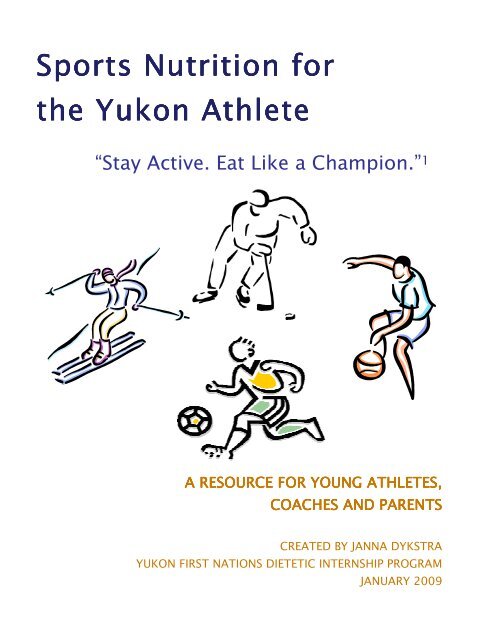

![Women and Alcohol: A women's health resource [2326.26 KB ]](https://img.yumpu.com/22340649/1/190x245/women-and-alcohol-a-womens-health-resource-232626-kb-.jpg?quality=85)
